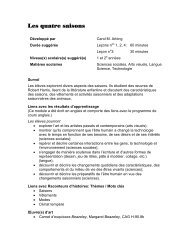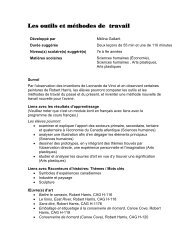Women's Role in the Mi'kmaq Community Long Ago
Women's Role in the Mi'kmaq Community Long Ago
Women's Role in the Mi'kmaq Community Long Ago
You also want an ePaper? Increase the reach of your titles
YUMPU automatically turns print PDFs into web optimized ePapers that Google loves.
allot sheets and have students write down whom <strong>the</strong>y believewould make a great chief. Insist that <strong>the</strong>y choose a person whoholds <strong>the</strong> qualities <strong>the</strong>y listed on <strong>the</strong> blackboard (this is not apopularity contest). Tell that students <strong>the</strong>y will have to wait untilnext class to f<strong>in</strong>d <strong>the</strong> results.Ideas for AssessmentObservation would be <strong>the</strong> key assessment tool for this lesson. Some studentsmight show lack of respect / negative attitudes toward this lesson; <strong>the</strong>refore, youmust be ready to deal with <strong>in</strong>appropriate comments <strong>in</strong> such a way that studentsunderstand and learn.Lesson #3: Keepers of TraditionsObjectiveStudents will become familiar with <strong>the</strong> traditions that Aborig<strong>in</strong>alwomen keep alive <strong>in</strong> <strong>the</strong> community.Related Art Work• Indian Woman, Robert Harris, CAG H-180Materials• piece of wood ( approx. 10'’- 12'’ long x 3'’ <strong>in</strong> diameter), with <strong>the</strong> outer barkremoved, one per student (students might br<strong>in</strong>g to school). Woodendowels, paper towel rolls, or anyth<strong>in</strong>g that resembles a stick might beused.• permanent markers• ribbon (optional) one 12'’ long• fea<strong>the</strong>rs (optional) two per student• pony beads (optional) two per student(These items are available at various discount stores)Activities1. Prepare a Talk<strong>in</strong>g Stick before <strong>the</strong> class. It can be used as a visualaid for students as well as <strong>the</strong> Talk<strong>in</strong>g Stick for <strong>the</strong> Talk<strong>in</strong>g Circleactivity.2. Tell students Aborig<strong>in</strong>al women were keepers of traditions, culture,and language. When <strong>the</strong> community came toge<strong>the</strong>r, a Talk<strong>in</strong>g Stickwould be used dur<strong>in</strong>g Talk<strong>in</strong>g Circles. Talk<strong>in</strong>g Circles were used tosettle an argument with<strong>in</strong> <strong>the</strong> community, help <strong>the</strong> community healfrom a tragedy, or to celebrate.
3. Expla<strong>in</strong> that, while <strong>in</strong> a Talk<strong>in</strong>g Circle, a Talk<strong>in</strong>g Stick is used toma<strong>in</strong>ta<strong>in</strong> order <strong>in</strong> <strong>the</strong> Circle. The only person allowed to speak is<strong>the</strong> person hold<strong>in</strong>g <strong>the</strong> Stick. Everyone else must listen. In <strong>the</strong>Talk<strong>in</strong>g Circle everyone is equal.4. Have students draw designs on <strong>the</strong> stick. Wrap ribbon around topand come down 1/4'’ leav<strong>in</strong>g enough ribbon ends for attach<strong>in</strong>gbeads. Glue beads to ends of ribbon. Insert fea<strong>the</strong>rs <strong>in</strong>side beadswhile glue is wet.5. Display Indian Woman. Tell students this will be <strong>the</strong> topic ofdiscussion dur<strong>in</strong>g <strong>the</strong> Talk<strong>in</strong>g Circle. Have students sit <strong>in</strong> a circle.Expla<strong>in</strong> Talk<strong>in</strong>g Circle once aga<strong>in</strong> and have students share <strong>the</strong>irfeel<strong>in</strong>gs / thoughts about <strong>the</strong> art work. If <strong>in</strong>dividual students do notwish to talk, <strong>the</strong>y can pass <strong>the</strong> Talk<strong>in</strong>g Stick to <strong>the</strong> next person on<strong>the</strong>ir left. The Talk<strong>in</strong>g Circle cont<strong>in</strong>ues until everyone hasexpressed <strong>the</strong>ir feel<strong>in</strong>gs.Ideas for AssessmentAssess <strong>the</strong> Talk<strong>in</strong>g Stick that students make accord<strong>in</strong>g to <strong>the</strong> criteria established.Observe responses made dur<strong>in</strong>g <strong>the</strong> Talk<strong>in</strong>g Circle.Lesson #4: Aborig<strong>in</strong>al Women of TodayObjectiveStudents will explore <strong>the</strong> different roles Aborig<strong>in</strong>al women portray <strong>in</strong>today’s society, and any stereotyp<strong>in</strong>g <strong>the</strong>y may have regard<strong>in</strong>gAborig<strong>in</strong>al people will be addressed.Materials• unl<strong>in</strong>ed paper (8 x 14)• pencil• coloured pencils, markers, crayonsActivities1. Review <strong>the</strong> roles Aborig<strong>in</strong>al women had long ago from previouslessons, writ<strong>in</strong>g responses on <strong>the</strong> board. Ask students what <strong>the</strong>yth<strong>in</strong>k Aborig<strong>in</strong>al women’s role is today and note <strong>the</strong>se responses aswell. Hopefully, <strong>the</strong> student’s responses will <strong>in</strong>clude teachers,students, mo<strong>the</strong>rs, doctors, carpenters, welders, lawyers,professors, curators, etc.
2. Discuss with students why it may be that many havemisconceptions about present day roles of Aborig<strong>in</strong>al women. Howmight <strong>the</strong>se misconceptions be corrected?3. Once students have ga<strong>in</strong>ed understand<strong>in</strong>g of and respect for <strong>the</strong>roles of Aborig<strong>in</strong>al women, both <strong>in</strong> <strong>the</strong> past and today, have <strong>the</strong>mwrite two diary entries, one speak<strong>in</strong>g as an Aborig<strong>in</strong>al woman of <strong>the</strong>past and one from <strong>the</strong> present. They might write about all <strong>the</strong> tasks<strong>the</strong>y have had to do dur<strong>in</strong>g that day, <strong>the</strong> problems and joys, <strong>the</strong>hopes for tomorrow.4. Once <strong>the</strong> diary entries are complete, <strong>in</strong>vite students to share what<strong>the</strong>y have written. Students might also decorate <strong>the</strong>ir diary entries,us<strong>in</strong>g colours and symbols that are appropriate.Ideas for AssessmentNote <strong>the</strong> sensitivity with which students write about <strong>the</strong> roles of o<strong>the</strong>rs.Wrapp<strong>in</strong>g up <strong>the</strong> Learn<strong>in</strong>gIt is important to emphasize that Aborig<strong>in</strong>al people today do not live <strong>in</strong> wigwams,but <strong>in</strong> homes. They now have elections for chiefs and work <strong>in</strong> <strong>the</strong> broadercommunity.Suggested Resources• www.<strong>in</strong>ac.go.ca• www.aborig<strong>in</strong>alcanada.ca• www.firstnationhelp.comPossible ExtensionsEncourage students to br<strong>in</strong>g <strong>in</strong> posters, newspaper articles, etc. about Aborig<strong>in</strong>alpeople today who fulfill roles such as teachers, lawyers, actors, musicians,artists, etc.Invite a Mi’kmaq woman to class and ask her to speak about her role <strong>in</strong> hercommunity today.





